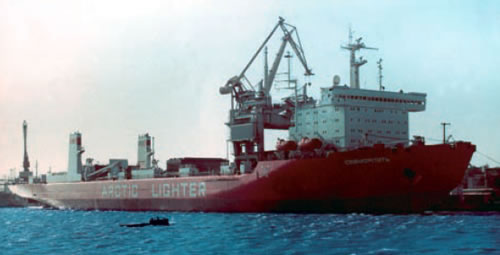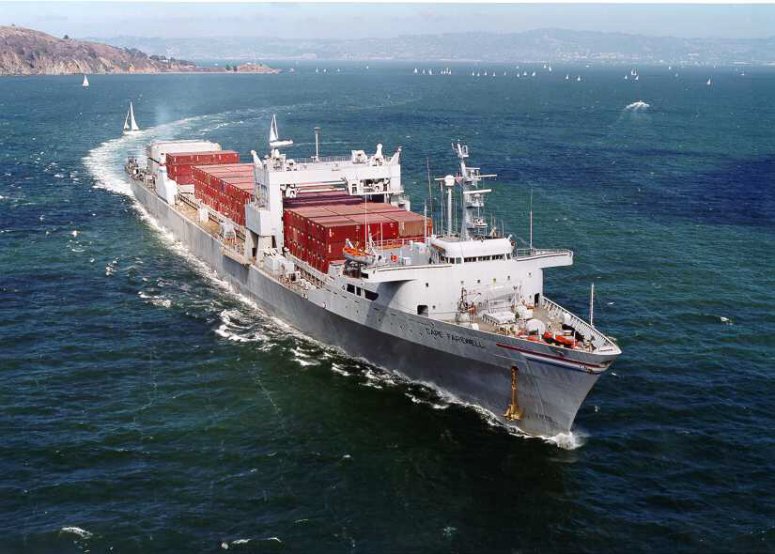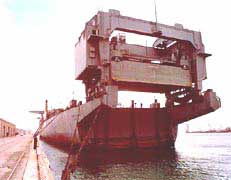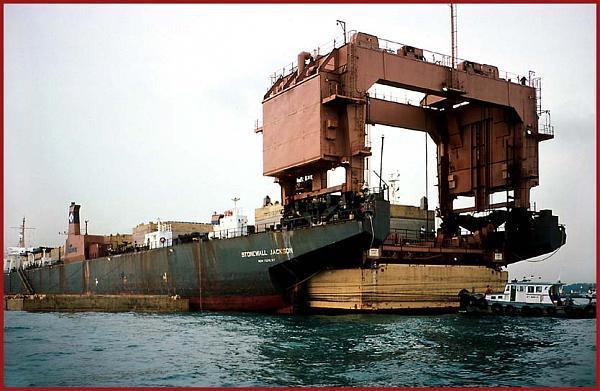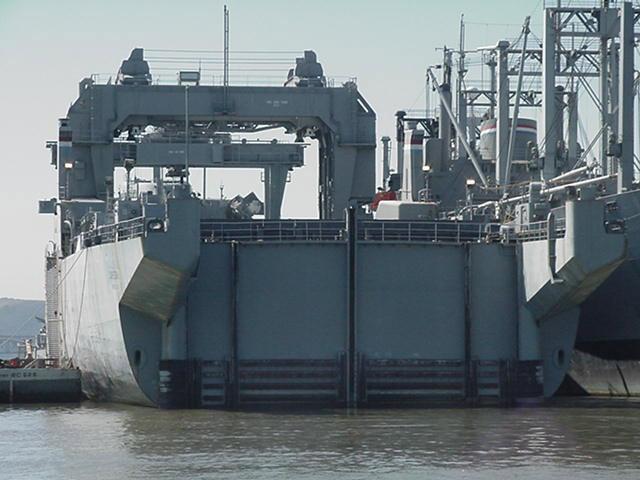Lighter Aboard Ship
The term LASH ( Lighter Aboard Ship) stands for a system to be transported at the loaded barge on ocean-going ships.
- 4.1 Specifications
- 5.1 Specifications
- 6.1 Specifications
Development
The range of Seeschiffstypen has been extended to another type in September 1969. With the commissioning of the Acadia Forest of transport ships in the ship took to connect through seas separate inland waterways its beginning. A large carrier ship takes as Light, barges, lighters or barges designated Vessels without their own drive in the form of floating standardized cargo containers. In the port of destination, the carrier ship separates again from this ship vessels. They are moved there in port waters, on canals and rivers as vehicles of inland navigation in convoys. The support ships are referred to as LASH carriers, barge carriers, kangaroo ships or barge transport ships. Another term for this type of ship was Light mothership.
Economic Importance
Irrespective of the harbor situations, each barge carriers should be around five times more freight transport than the then usual conventional general cargo ships. It was also a special interest in this type of vessel in the early 1970s and the associated thought him so optimistic future prospects. Seaborne cargo transport corresponded already in the 1950s no longer meet many maritime customers. A rationalization of the then general cargo could only be reached through a standardization of their dimensions, shapes and in their external condition often very different batches of cargo. Worldwide sat down in the 1960s only slowly through the standardized ISO containers. The large container terminals with its extensive conveyor systems and the huge storage areas were still being planned or in development. Under these conditions, offered the LASH carrier system with its barges, which are to be characterized as a floating container, as an alternative and complement to the developing container traffic. At that time, transportation experts thought a promising and efficient transport technology. When the barges, there was no time pressure in the loading and unloading. Inadequate handling equipment for the ports and missing Kailiegeplätze had no effect on the operation of the carrier ship. While the Light were unloaded and loaded, the carrier ship with other barges was already on the road again. It had thus become possible that these ships spent more than 80 % of their annual operating time at sea. Conventional ships were often half of their annual operating time in port.
However, the type of ship could not enforce themselves. For the cargo lash barge were only partially operational by reason of their almost square shape. Here heavy machinery, cotton and bagged cargo were transported mainly. Therefore, the transport concentrated primarily on special mass goods which are not worth having bulk carriers due to their relatively small amount.
Another problem was that in Europe - unlike the United States - the existing capacity to push boats not sufficient, since the push boats in Europe were mainly used for sliding from much larger barges in the transport of ore, coal and oil.
Ultimately, this type of ship was therefore completely replaced by container ships.
Main transport lines were the routes between New Orleans ( Mississippi) on the one hand and Rotterdam and Bremerhaven on the other side of the Atlantic.
Construction costs
For the former period, the high handling capacity of more than 1500 tons per hour of LASH and Seabee ships were impressive when you consider that peak powers in conventional cargo handling amounted to less than 100 tons per hour. Even the emerging modern container facilities coped with just 1,000 tons per hour. The enthusiasm for the barge carrier was, however, dampened by the high investment costs. In 1972, the cost of building a LASH ship in Belgium amounted to DM 50 million and still in the U.S., about 25 million U.S. dollars. For a Seabee carrier ship about 35 million U.S. dollars were estimated. Still belonged to the ship-borne lighters, of which, depending on the type, a lighter 40000-100000 U.S. dollar cost. Since each ship took more than a set of lightweight and only several lighter ships were economical to operate, had to be given an enormous investment. A fleet of ships and three Seabee the associated 246 barges cost after the price and exchange rate level in 1972 around 125 million U.S. dollars.
History
The LASH system was developed in the 1960s by the American naval architect Jerome L. Goldman. The world's first LASH Carrier was the Acadia Forest (1969). This type of ship could take 75 standardized Light with about 376 tonnes of cargo capacity. On 1 July 1978 29 Light ships were registered with a capacity of 0.775 million GRT ( gross tonnage ). For the same period there were 69,020 seagoing vessels over a hundred BRT (GT ) worldwide. Beginning of 1981 there were 34 barge carrier with more than 0.8 million GT ( gross tonnage ). Across the world, 1981 73.864 seagoing vessels over 100 GT (GT) road. The market share of Light ships was accordingly in 1981 about 0.2 % of transported cargo.
On 15 December 2007, the Rhine Forest ran, ex. Holland America Line Bilderdijk of, most recently Rotterdam. She was a sister ship of Munich. The LASH barge with the registration CG S 6013 the Association De Binnenvaart was passed in Dordrecht and is now part of the inland navigation museum.
Due to the poor utilization of the scheduled service between New Orleans and Rotterdam has been set. The Rhine Forest was scrapped in late 2007 in Chittagong.
Technology LASH system
An important technical problem in the realization of the new transport system was the envelope of Light. A distinguishing feature of the different projects and also built cars was the way how the barges were brought by or on board. The largest scope found the LASH system. Here, the Light were individually lifted out of the water at the stern of the carrier vessel by a huge gantry crane. This gantry crane could move over the entire length of the ship and stowed so the recorded Light several times over each other in the hull and on deck. The cranes have a lifting capacity of more than 5 Giganewton. The folding of a barge took on average 15 min.
LASH ships have been built in Europe, Japan and the United States had almost uniform parameters.
Specifications
The German Hapag -Lloyd AG presented in 1972 a LASH ship, Munich, in service. This ship is sunk in December 1978 in the Atlantic.
Seabee system
The first ship of a series of three Seabee ships was the Doctor Lykes. As Seabee ( eng. Seebiene ) a system is known in which there is disposed a lift at the rear of the support vessel. This lift is also called Synchrolift. This has a lifting capacity of over 2000 Mp The synchro lift is lowered below the water surface. In this underwater platform two to 1,000 tons will be swum heavy barges and raised from these into the corresponding deck height. On special rail car to barge ship in the longitudinal direction are rolled to their storage places. On the three decks of the Doctor Lykes 38 Light could be jammed, with one each 12 on the lower deck and 14 on upper deck. Noteworthy is the dual function of the ship. The side tanks and the unusually large double floor of the vehicle constituted a tank capacity of 36,000 m³ capacity dar. So the ship could also be used as product tankers. The Light used in the Seabee system are significantly larger than the LASH barges.
Specifications
BACAT system
End of 1973, a Danish project called BACAT ( Barge - Catamaran ) was presented. The plan of the transport of several hundred thousand tons of cargo between the mouth of the Rhine / Rotterdam and Hull was on the Humber. The BACAT system resembled the Seabee system. The Light, however, were small and only had a capacity of up to 140 t. The Bacat I was the only ship of its type on 5 September 1973 of Frederikshavn Vaerft A / S from the stack and was completed on 28 February 1974. After about a year, and 132 per 60-hour round trips including Easy change had been transported to the existing six Light sentences about 60,000 tons. Problems with the English dockworkers' union led to the discontinuation of the service. The ship was first launched in 1976 with 63 barges to the shipping company MacKinnon MacKenzie Co. Ltd.. sold. It then drove a service between Bombay in India and the Persian Gulf, but was canceled in Bombay back in 1986.
Specifications
There were ten of each BACAT Light on deck and either three or LASH barge eight BACAT Light in the catamaran -like hull to be transported.
Other Projects
In addition to these types of carriers there were other projects. There was a proposal to take over the Light at the bow of the ship. Another variant was einzuschwimmen the Light of a floodable compartment of the carrier vessel through an opening in the hull.
A technically interesting idea was published under the name Stradler system of the New York engineer Frank Broes. Between the hulls of a catamaran ten motorized Light should be included with a carrying capacity of about 12,000 deadweight tons.
→ see also: Baco -Liner
Problems and risks
With the use of barge carriers, problems arose that were the maritime shipping companies previously unknown. Aboard the carrier vessel of Light is nothing more than a large cargo vessel. In the seaport and inland waterways it is to the watercraft. This results in requirements result in equipment requirements such as anchors, hauling, coupling devices, Signal and. Position lights. For compiled pushed convoys so-called head barges had to be provided. These rules can be quite different in the various ports in Europe, North America and Asia. Complexity, the transport system designed for the servicing of the waterways that freeze in winter and there was a setting of the inland navigation operation. This required a high investment. This effort, coupled with the risks for economic operation of the carrier vessels and their Light, demanded conscientious traffic economic studies that were much more complex than for conventional cargo ships and for container ships conquering the market and their transport system. Barge carriers and barges provide a technologically interesting maritime transport system dar. Economically, they are just as many specific traffic- economic conditions are met.



